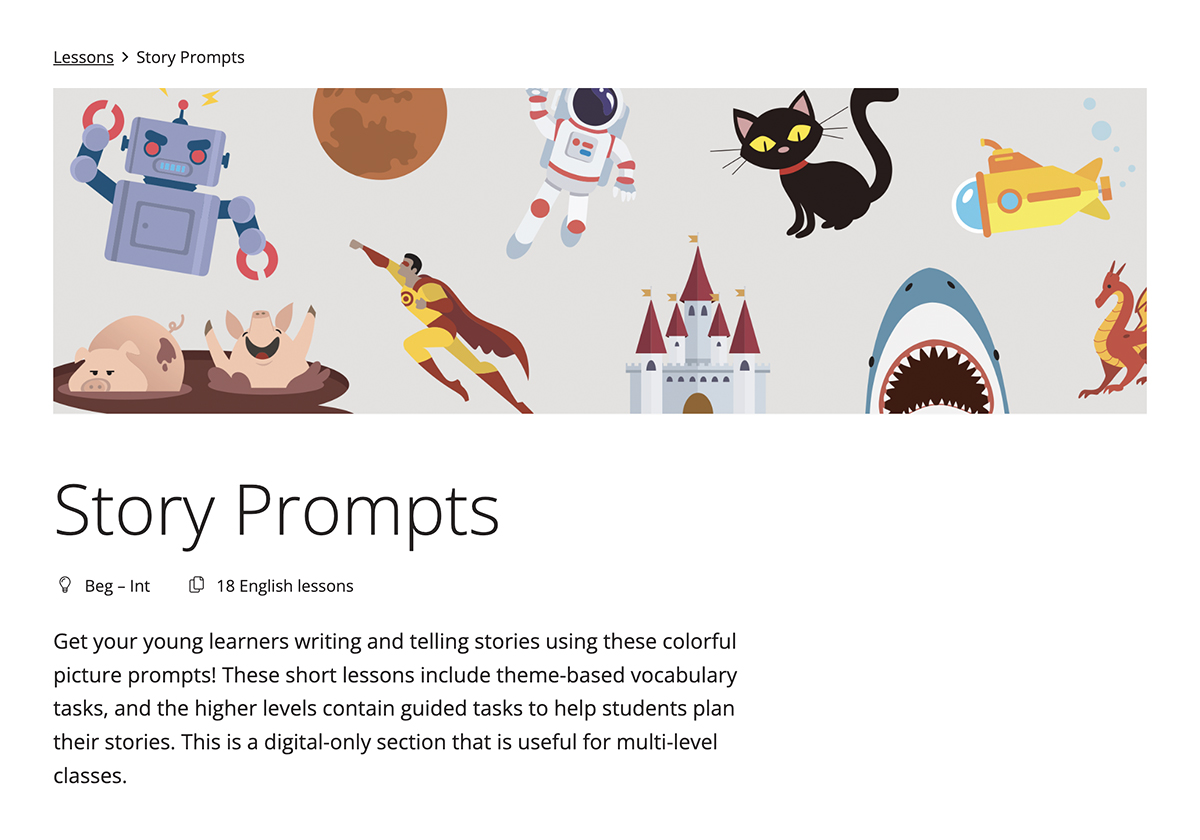At Ellii, we enjoy using our creative skills to develop materials that teachers and students love! Let's go behind the scenes to see a fun project the Publishing team worked on this year.
Genius Hour
Did you know? Ellii's popular Story Prompts and Picture Stories sections were born out of Google's Genius Hour concept where staff are given free time to create.
Ellii's illustrators, Saori and Steve, were given creative license to come up with their own ideas for lessons while playing with some new illustration styles.
After spending time experimenting with some visual concepts, they worked with Ellii's writers and editors to build out templates that eventually became full lesson sections for beginner-level learners.
A hackathon for Ellii's Publishing team
A few months ago, Ellii’s Publishing team heard that our Product team of developers was going to try a hackathon, which is a time set aside for them to play with code and aim to build something fun or solve a problem.
The Publishing team decided they wanted to do something similar.
At the TESOL conference earlier this year, Tara, our VP of Publishing, was inspired by the theme of wordless stories, which came up in some sessions.
Wordless story: a book without text where the story is told solely through the art
She divided the Publishing team into two groups (Wordless Video team and Wordless Picture Story team) to explore this idea.
In addition to giving creatives a chance to do something new and fun, this project gave team members an opportunity to collaborate with people they may not work with every day.
Here are the finished products:
Wedding Receptions
Think inside the Box
Wordless picture stories and their benefits
When each team had finished their product, they presented it to the entire Publishing team.
Here is some useful background about the Think inside the Box wordless picture story lesson, which was inspired by an article about schools and curiosity.
Lesson objective: To promote creativity, develop new vocabulary, practice basic tenses, check understanding of Wh-questions, and assess speaking skills. This story can also be used to promote social-emotional learning (SEL).
How wordless lessons develop creativity and SEL
Creativity needs to be an active part of learning—not something that’s nice to have if time allows.
ISTE’s research shows how integral creativity is in healthy socio-emotional growth. This applies to learners of all ages. Emotional development and self-esteem are promoted through creative learning.
“Teachers who frequently assign classwork involving creativity are [more likely to observe] higher-order cognitive skills.”
Wordless stories encourage students to be the storyteller.
This kind of activity builds on students' prior knowledge, activating schemata and developing language/communication skills.
For WIDA teachers, this kind of activity takes student assets into account as the story can be told from students' perspective. Furthermore, the same story can also be told in many different ways with the target language scaffolded by the teacher (can focus on simple adjectives, tenses, questions and answers, adverbs, sequence markers, etc.).
Wordless stories and Bloom’s Taxonomy
Ellii's wordless stories will allow students to develop higher-order thinking skills as well as to review and strengthen the lower-order skills.
Providing a cognitive challenge will help students develop their language and communication in addition to their socio-emotional skills.
Remember: What happened before? Who are the characters? What did they do?
Understand: Predict what will happen next. Describe what’s happening now.
Apply: Organize the story and arrange the sequence. Write a brief description.
Analyze: Compare your story with a classmate’s. How are they similar/different?
Evaluate: Reflect on your story. Go back and apply feedback from classmates and teacher.
Create: Propose the next part of the story. What happens next?
Task types in Ellii's Think inside the Box wordless lesson
Every task type plays a specific role in developing your students' literacy skills and supporting their language-learning journey.
Warm-Up Questions
- serve to activate prior knowledge
- take into account student assets and backgrounds
- provide a hint as to what the content is going to be about
Image Match
- provides some of the language students will encounter and use
- allows for students to interact with the vocabulary
- encourages students to ask questions
Picture Story
- enables students to use the language and respond to the prompts
- encourages creativity and collaboration—students can work together or individually to think of the story
- encourages the target language (the teacher can direct this however they see fit—e.g., parts of speech, colors, sequence markers, Wh-questions, etc.)
Speaking Task
- encourages students to remember what was discussed in class
- allows students to reproduce the story with their own ideas
- gives students a chance to use their own creativity
Virtual classroom and in-person classroom ideas for wordless lessons
These activities can be modified for either context. Students in an online classroom can work together in breakout rooms in synchronous class sessions. The teacher can share their screen and then assign the tasks to students individually or in pairs/small groups.
In-person or face-to-face (F2F) classes can use the digital activities easily by projecting the images onto a screen and encouraging students to collaborate. Live F2F classes can also take advantage of the in-person element by encouraging role-plays and then acting out the storyline.
Regardless of whether students are in virtual or live classes, creativity can be encouraged in many ways.
Ask students to find a real box (tissue box, TV box, etc.) to use as a prop for their story. Adding a tactile or kinesthetic approach can help facilitate learning by engaging other senses.
Share your thoughts!
Wordless stories and videos are a tool that you can adapt and use to fit your students' learning goals and objectives.
By taking student assets into account and engaging creativity, the teacher encourages students to take part in their own "Genius Hour." Teachers, give it a try! Let us know what your students created.







